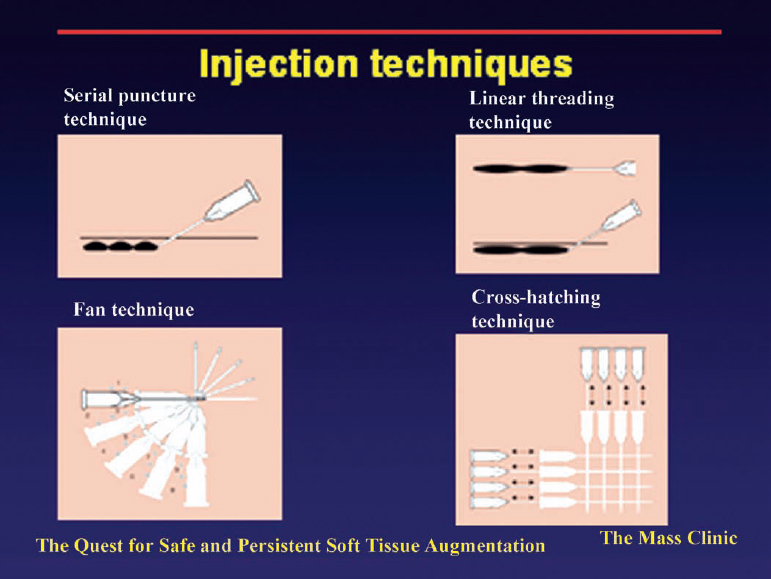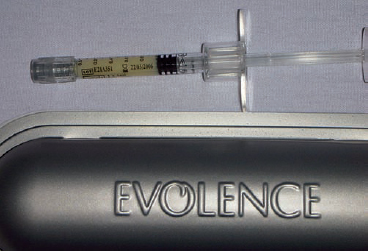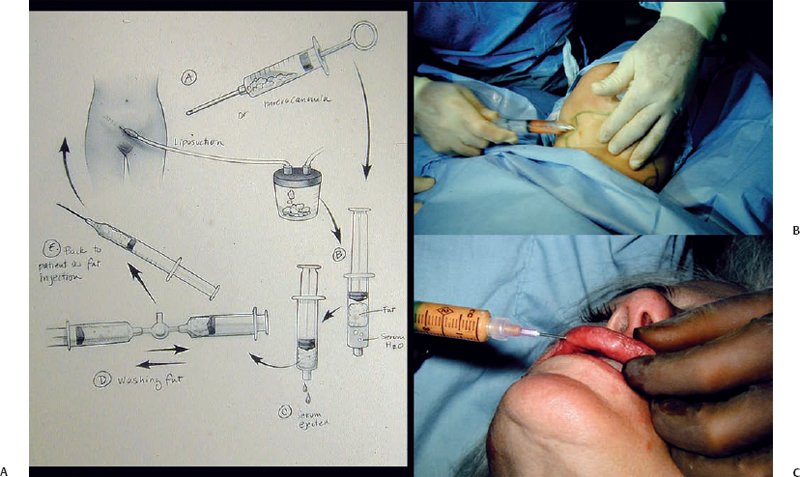11
Soft Tissue Fillers
Corey S. Maas, Kevin H. Ende, and David A. Lewis
The portfolio of products available for surgeons in the soft tissue filler market has grown rapidly over the past several years. Clinical indications have expanded beyond just simply treating nasolabial folds and lip augmentation. Today, fillers are used for all types of facial contouring and fine line management. Market awareness has increased dramatically with the advent of Restylane (Medicis Aesthetics, Scottsdale, AZ) and successful advertising and marketing campaigns. Additionally, there is a huge demand from the baby boomer generation, who want minimally invasive treatments to improve the changes associated with aging, including the development of rhytides and the loss of facial contour.
When studied carefully, it is an interesting dilemma for surgeons. The return on investment for performing injectable soft tissue augmentation and/or neuromodulators in terms of time spent with patients is dramatically better than with surgical procedures, even in the cosmetic arena. These procedures in addition provide an entrée for patients for relationship building with the surgeon that may lead to future surgical procedures. The real dilemma that has occurred in recent years relates to whether or not busy cosmetic surgeons should use nurse or physician-assistant injectors as an adjunct to their surgical practice and as physician extenders. Using these providers represents a double-edged sword in current practice, as they diminish the ability of the surgeon to develop an intimate relationship with patients, which relationship may ultimately result in surgical cases. The key to success with the plethora of products available is being able to position them well within your practice. As providers, we need to be able to explain to our patients why we use certain products for certain areas, and this may include several different products for a single patient.1 We must understand each product’s benefits and limitations and be able to successfully explain these to our patients.
♦ Injectable Fillers: The Quest for Durability and Predictability
For purpose of classification, we have placed the available soft tissue fillers into a handful of basic categories. These include injectable biological materials, injectable synthesized bioactive materials, and injectable synthetic materials.
The techniques employed using these various materials include serial puncture, linear threading, fanning, and, of course, cross-hatching, with the latter two being primarily used for facial contouring (Fig. 11.1). The long-held thought that all fillers should be injected intradermally has now been challenged by many clinicians who use the hyaluronic acid (HA) fillers subdermally. Some other products, such as Sculptra (Dermik Laboratories, Bridgewater, NJ) which will be discussed later, are injected even deeper. Clearly, most collagen products and, in particular CosmoDerm (Allergan Inc., Irvine, CA) are excellent products for intradermal use in the augmentation and correction of fine lines.
Tissue-Derived Biologics
Among the biologic products that are tissue derived include:
- Autologous fat
- Zyplast (Allergan, Inc.)
- Resoplast (bovine collagen; Rofil Medical International, Breda, Holland)
- Evolence (porcine collagen; Colbar Inc., Tel Aviv, Israel)
- Hylaform and Hylaform Plus (HAs derived from cock combs; Genzyme Corporation, Cambridge, MA)
- Fascian (Fascia Biosystems, Beverly Hills, CA) or heterologous particles of fascia
- Cymetra (LifeCell Corporation, Branchburg, NJ)
- AlloDerm (heterologous sheets of dermis; Lifecell Corporation) and Surgasis (porcine sheets of product)
These products in general are effective and soft to palpation but have definite half-lives in vivo. Most of the biologic fillers as described are derived from animal tissues. These include bovine collagen from cowhide, Dermalogen (Collagenesis Corporation, Beverly, MA) and AlloDerm, as well as others from human tissue, and Hylaform, which is derived from the combs of roosters. These are carefully synthesized and purified and placed in sterile syringes for immediate use off the shelf.2
Among the more interesting of the recent developments is a porcine collagen called Evolence (Fig. 11.2). This product has recently been acquired by Johnson & Johnson, which is developing an aesthetic care unit. Clinical trials are under way in the United States, and the product promises 1-year duration with deep dermal or subcutaneous placement.

Fig. 11.1 Various injection techniques for soft tissue augmentation.

Fig. 11.2 New collagen product Evolence promises up to 12 months’ duration.
AlloDerm and Surgasis are products that are derived from acellular dermis, Surgasis being from porcine dermis and AlloDerm being human derived. These require rehydration prior to implantation, and whereas their effectiveness was once touted as being permanent, most believe now that these products last from 6 to 12 months before reabsorption occurs. Autologous fat transfer is very popular and appropriate, in particular for facial contouring cases. In our experience, fat has limited value in lip, nasolabial fold, and tear trough deformities due to its unpredictable nature of reabsorption. With that said, autologous fat transfer remains one of the standards of care as it is quite easy to harvest fat from areas of fat excess, to centrifuge and/or wash the fat carefully, and to carefully prepare it for easy injection with a small-bore needle in cases of facial contouring.3 Most of the data associated with autologous fat suggest that it requires very careful handling and limited trauma to have long-term success. In general, extensive local nerve blocks are performed prior to fat transfer with gentle handling of the fat, and the best chance of success with fat transfer employs fine streaks or beads of fat applied in the deep subcutaneous tissue close to muscle (Fig. 11.3). One to 4 weeks of recovery are required for this because of the extensive swelling seen with fat transfer, and probably the best one can expect is 25 to 50% correction for intermediate- and long-term results.

Fig. 11.3 (A) Autologous fat transfer technique. Fat is harvested using a microcannula. It is then processed and washed to purify the fat. Various sizes of microcannulas are used for injection using linear threading techniques for soft tissue augmentation. (B) Fat harvest can be done during submental liposuction. (C) Fat transfer to the lips.
Each of these biological products has its advantages and disadvantages. In general, the main advantages include that they are injectable, they require limited anesthesia, and they are generally well accepted by patients, as they are soft and natural feeling. With the exception of fat transfer, these products have a very short recovery period. The disadvantages, particularly in the animal-derived products, include the possibility of hypersensitivity reactions, which, for example, occur in 1 to 4% of patients injected with bovine or porcine collagen.4 These products generally have a temporary effect due to reabsorption, which can be a disadvantage as they require repeat injections; however, this can also be looked at as somewhat of an advantage as it negates the long-term risk of granuloma formation or infections that can be associated with permanent and synthetic injectable materials.5,6
Synthesized Bioactive Products
The synthesized bioactive products that are currently available include CosmoDerm and CosmoPlast, which are recombinant human collagen products; Radiesse, which is composed of calcium hydroxylapatite; Restylane, which is recombinant HA; Captique, which is recombinant HA; Sculptra, which is polylactic acid; and Juvéderm, which is homogeneous HA.
All these products are effective, soft, and reliable, although sometimes they can result in modest amounts of inflammation that typically will last 1 or 2 days. Human collagen is provided in the form of CosmoDerm and CosmoPlast, which are manufactured using recombinant technology and have similar handling characteristics to the previously known Zyplast and Zyderm products.4,7 This requires no skin testing, and in our practice CosmoDerm remains the product of choice for intradermal injection to treat fine lines.
These products are tissue-engineered from human dermal fibroblast cells. They are allowed to multiply on a collagen scaffold and the collagen is then harvested, placed in syringes, and refrigerated until used. Another benefit to collagen is that it appears to enhance platelet aggregation, which may decrease bruising. Additionally, it contains lidocaine, which negates the need for local nerve blocks and reduces pain. In addition, there may be some benefit in local reduction in eosinophil degranulation, which theoretically results in decreased swelling, making it the injectable filler with the least amount of down-time.8
Stay updated, free articles. Join our Telegram channel

Full access? Get Clinical Tree








